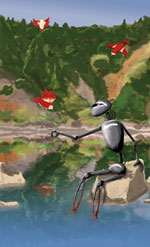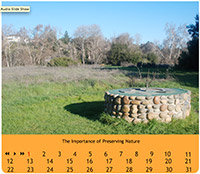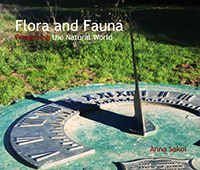- Home
- English
- Web
- Design
The third unit at Freestyle is the Documentary unit. In this unit I learned to use a lot of new and different programs. In Web/Audio we learned how to use Pro Tools and Reason. We also expanded our knowledge of ActionScripting in Flash and we learned to use Javascript in Dreamweaver. In Design we learned how to use InDesign. In Photoshop I learned new techniques for editing photos.
Perhaps my greatest accomplishment was improving my digital painting technique. Painting instead of coloring lineart has always been difficult for me, and with "Reconciliation" I feel that I pulled it off fairly well. Another aspect of that piece that I am proud of is the background. I sometimes have trouble drawing and painting suitable backgrounds, and while I do not think the background of "Reconciliation" is perfect, it is a great improvement on my previous attempts.
The music that can be heard on this page is an original composition done by me. It is entitled "Jingle."
For this unit in English class we wrote research papers. The assignment was very open-ended. Each student chose a topic that interested him/her. The only restrictions were that it had to have an interesting visual aspect to it and we had to be able to get at least three interviews about our topic. The final form of the paper is in a photo book or article format, created in Design class, and the same interviews are used in an audio slideshow for Web/Audio class.
The papers focus around a central question or idea. My question is, "What is the importance of preserving nature?" I visited the local McClellan Ranch in Cupertino, CA to take photos and interview people working at the nature preserve and 4-H farm. As a member of that 4-H farm myself, I was interested in learning how nature affected other people, and why they thought it was important for society.
Flora and Fauna: Preserving the Natural World
The telephone was invented in 1876, the light bulb in 1879. Television came in 1927, and the Internet was invented in 1973 (CBC). Today we live in a society where almost everyone has their own computer, MP3 player, and cell phone.
All of these new technological improvements are just fine, but with all this moving forward, what is being left behind? As we move more and more into the digital age, technology is taking over nature. People spend more time on their computers than they do outside. We have become caught up in our obsession with technology. In 2002, a man from Massachusetts killed himself after becoming addicted to the computer game EverQuest, and in the same year a South Korean man died after gaming for 86 hours straight. In 2004, a Shanghai man stabbed his friend for selling a game sword that they won together in a computer game. In 2006, a British bus driver was caught playing games on his handheld device while driving (Age).
Not all people see this as a problem, however, they think that these incidents are the exception rather than the rule, but how long before these events become more common? As technology progresses, many people are thinking less and less about nature. What is the importance of preserving nature?
While much of our world is being overtaken by cities and suburbs, and with them technology, there are still places that strive to preserve nature. One such place is McClellan Ranch, in Cupertino, California. It is a city owned nature preserve and host to many community organizations, the largest two being the Rolling Hills 4-H Club and the Santa Clara County Audubon Society. The City Parks and Recreation Department also has an office there. Before understanding why this ranch plays such an important part in the local community, we first must understand why the park exists in the first place.
McClellan Ranch has long been utilized as a place of nature and sustainability. One of the reasons for this is the unique geographic makeup of the 18-acre park (Cupertino). Barbara Banfield is the naturalist who works at McClellan Ranch for the Cupertino Parks and Recreation Department. She says that when people ask her about the history of McClellan, she starts out by telling them to look out at the large field that sits near the entrance of the ranch. “When you look out at the field, and then turn around and look back up toward the road toward the road you can see that it’s very flat, the center of the field, and that’s the result of a lot of flooding, year after year of flooding, laying down soil (Banfield).” This flat level area is actually the bottom of a valley, cut out as the Santa Cruz Mountains to the west rose; this, combined with the adjacent creek, temperate climate, and sheltering hills, make it an ideal place to settle down.
The first people to discover this sanctuary were the Ohlone Indians. Stone mortars have been found in Stevens Creek, which runs through the ranch. The De Anza Party, who came through the area in the late 1700s, also gave testament to this fact. They said that there were Ohlone villages right on the banks of the creek.
After this came the Mission Era, and although there were not missions or settlements very close to this area, the Spanish rancho workers often let their cattle and other livestock roam freely. These cattle introduced European seeds to the area. Those seeds started to change the makeup of the flora in the field.
In the 1840s people started coming from the eastern United States. One of the first people who came was Elijah Stevens, who settled in the Blackberry Farm area, which is adjacent to McClellan Ranch. Although many of these early settlers moved on, more people quickly followed them, and there was a period of rapid development after the gold rush. The entire Santa Clara valley grew. The ranch was converted into a dairy cattle farm. One of the pioneers in artificial insemination worked on the cattle there. After that, it was converted into a horse ranch, and alfalfa was planted in the field.
What came next was a major step in the ranch’s history. The city of Cupertino bought the land for public use in the early 1970s. For a time, the community was unsure of what its use should be. They considered making it a golf course, a landscape park, or playing fields. Finally, because of a growing interest in the environment, the city made it into the nature preserve that it is today.
Now we know why it exists, but the question remains: what does it do? Each organization that is housed there serves, at least on the surface, a different purpose. When we look to the ultimate goal, however, we find that they are the same: preserving nature and environmental education.
The Cupertino Department of Parks and Recreation has an office located at McClellan Ranch, and the naturalist who oversees it is Barbara Banfield. She does a lot of things at the ranch. She leads programs; nature walks, and maintains the nature museum and its animals. “Thousands of kids come through here every year for the programs,” Banfield says. She also oversees the community gardens in the park, known as the Master Gardener McClellan Ranch Project. Established in 1989, it is one of the oldest Master Gardener projects in Santa Clara County (Master).
Another organization that has an office at McClellan is the Audubon society. Before they moved to the ranch, Toby Goldberg, the Programs Coordinator, says, they had a tiny office two room office located in the city. The ranch gives them space to expand their operations. The Audubon Society also runs programs for kids and families. The Santa Clara Valley Audubon’s motto is “connecting people with nature,” and that, according to Toby, is exactly what they try to do. They are able to expose nature to people who would not normally experience it.
The last main organization at the ranch is the Rolling Hills 4-H Club. I myself am a member, but I also spoke to my fellow member, Iris Young. “4-H is a youth development program that focuses on teaching life skills through hands-on activities,” she tells me, “And the Ranch is what gives us that opportunity” (Young). The 4-H club is divided into projects, and members can decide which projects they want to join. Some of the projects involve activities that the youth would not be able to experience anywhere else, such as raising goats, swine, and steer. Most of the 4-H members live in cities that do not allow them to keep livestock, so by making McClellan accessible, new doors are opened for the youth of the surrounding cities. The projects that make use of the ranch are the Poultry, Dairy Goat, Pack Goat, Pygmy Goat, Beginning Goat, Swine, Steer, Miniature Horse, Woodworking and Electrical, and Beekeeping Projects.
I first joined 4-H when I was in sixth grade. I have been in the Poultry, Communications, Leadership, Dairy Goat, and Pygmy Goat Projects. Since then I have learned a lot. I have been the Teen Leader of the two different projects, and the Treasurer and Vice President of the Club. My public speaking and leadership skills have improved a lot because of my experiences in 4-H. Over the years I have watched other join 4-H and grow all because of the ranch.
The Parks and Recreation Department teaches people about nature and gives them a place to learn about it. The Audubon Society promotes nature conservation, and 4-H promotes youth development. But the one thing that all these organizations do well is bring the community together.
Nature gives people a place to get away from their daily lives. Natural places are very rare, and so when people actually get out and experience them it is a unique experience. When asked, each of my interviewees said that having access to nature was very important, not just to them, but to society as a whole. Nature brings people together in a way that no other thing can.
Works Cited
Banfield, Barbara. Personal interview. 6 Mar. 2009.
"CBC Kids - History of Inventions, a timeline from Pottery to Computers." CBC.ca - Canadian News Sports Entertainment Kids Docs Radio TV. 20 Mar. 2009 <http://www.cbc.ca/kids/general/the-lab/history-of-invention/default.html>.
Cupertino : Home. 18 Mar. 2009 <http://www.cupertino.org/index.aspx>.
Goldberg, Toby. Personal interview. 13 Mar. 2009.
"Home | Master Gardeners of Santa Clara County." California Master Gardener County Links | Master Gardeners of Santa Clara County. 17 Mar. 2009 <http://www.mastergardeners.org/scc.html>.
"Home | Master Gardeners of Santa Clara County." California Master Gardener County Links | Master Gardeners of Santa Clara County. 24 Mar. 2009 <http://www.mastergardeners.org/scc.html>.
"Rolling Hills 4-H Home Page." University of California 4-H Youth Development Program. Ed. Jane Norton. 17 Mar. 2009 <http://clubs.ca4h.org/santaclara/rollinghills/>.
"Santa Clara Valley Audubon Society." 16 Mar. 2009 <http://www.scvas.org/index.php>.
"Ten signs you're tech obsessed." Theage.com.au. 28 Apr. 2009 <http://www.theage.com.au/news/technology/signs-of-tech-obsession/2006/07/05/1151779009040.html>.
Young, Iris M. Personal interview. 15 Mar. 2009.
The Audio Slide Show was the main project in Web/Audio class for the Documentary Unit. It was created in Flash, through the use of ActionScripting. I interviewed Barbara Banfield of the Cupertino Parks and Recreation Department, Toby Goldberg of the Santa Clara Valley Audubon Society, and Iris Young of the Rolling Hills 4-H Club. With narration by yours truly.
This entire slideshow was created in Flash using ActionScript. Although it was frustrating when it came time debug the whole thing, seeing the results were always worth it.
My article is a combination of the research paper I wrote in English and photos I took of McClellan Ranch. We learned to use Adobe's InDesign to create the layout of our books/articles.
In addition to doing the photo article in Design, I also created a digital painting to reflect the main idea of my research paper, "What is the importance of preserving nature?"
I painted the piece completely in Photoshop, something I had never done before. My usual style consists of drawing an image by hand, then scanning it into Photoshop, where I ink and color the lineart. With this piece I drew a rough sketch directly in Photoshop, then painted over it. I also experimented the new filters, blending modes, and adjustment layers.
 "Reconciliation" - Click on the picture for a larger image.
"Reconciliation" - Click on the picture for a larger image.
The ancient cultures held a much greater respect for nature than most do today. They had stronger ties to the earth. Before the relatively recent industrial, technological, and agricultural advancements the people depended on nature to provide for them. Nowadays, most people live in cities; they buy their food from a supermarket and watch television for entertainment. Before, people had to hunt for or grow their own food, and children would play outside. With the advent of technology it has become easier and easier to stay inside all of the time. I myself have gone an entire day without stepping outside once. Despite all of the technology surrounding me, however, I have discovered just how important experiencing nature is. I keep my goats at McClellan Ranch Park in Cupertino, California. I enjoy walking with a few of my goats out to the stream that runs through the park. Sitting there, listening to the birds and the creek always soothes me no matter what else is going on.
The robot sitting in the lake in my piece represents a return to nature. The rust all over the robot shows that I believe such a return is inevitable. We humans must be the ones to correct all of the wrongs we have done to nature. This is shown in the robot reaching out towards the bird. Technology, humans, and nature can all coexist peacefully.
Photo Article


